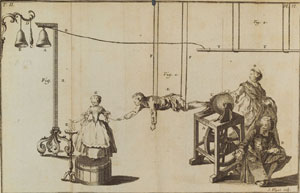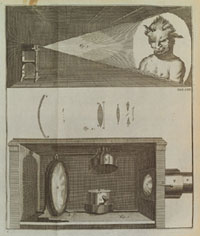Science Visualized and Popularized
 An electrical experiment from Sir William Watson, Recueil
An electrical experiment from Sir William Watson, Recueil
de
traités
sur l'electricité,
traduits
de l'Allemand &
de l'Anglois (Paris,
1748) –
Science,
Industry
and Business Library, NYPL
The
daunting effect of the underlying mathematics on the diffusion of Newtonian
ideas was also alleviated by the inventiveness of English and Dutch scientific
practitioners in designing scientific instruments – and devising ingenious
experiments – capable of establishing Newtonian principles. “Forces” and
the laws of motion suddenly became every bit as visual (and demonstrable) as
the refrangibility of light through a prism.
 Plate from Willem Jacob’s Gravesande,
Plate from Willem Jacob’s Gravesande,
Elémens de physique (Leiden,
1746) –
Science, Industry and Business Library, NYPL
Thanks
to the efforts of these university professors, instrument makers, and itinerant
lecturers, the scientific lecture-demonstration became the backbone of university
instruction in the natural sciences as well as a trendy form of public entertainment
among aristocrats and members of the middle class. The popularity of science
increased even more during the 1740s with the harnessing of electricity and
the coming into vogue of natural history.


